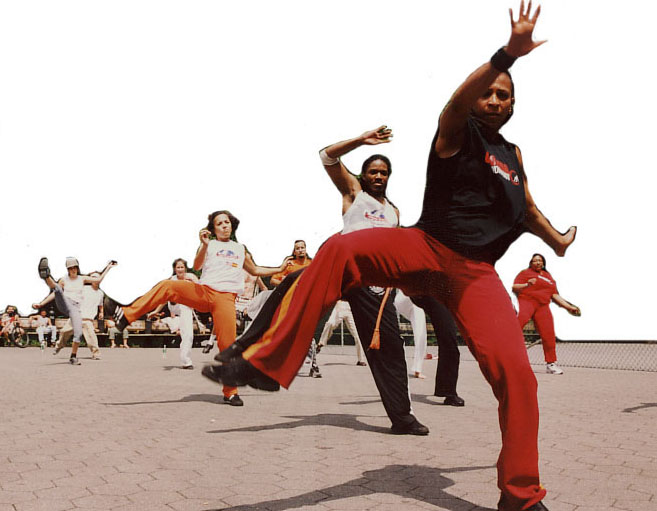|
The following excerpt is from the Adada Capoeira site. Please visit
EdnaLima.com, Capoeira Master and Olympian, for more information.
Origins
of Capoeira
Capoeira is a martial art developed in Brazil by
enslaved Africans.The true history of the art is unclear, but most people believe the following:
In the 1500's many Africans were taken from different areas of West Africa
and brought to Brazil to be used as slaves by the Portuguese. They were taken from their land, but their culture and desire
for freedom could not be taken away. With this need for freedom growing, these people began developing techniques for defending
themselves and for escape.
Of course slaves could not be allowed to practice martial arts, so
the development and practice of the art had to be disguised. The natural disguise for the art was as a dance being that in
Africa dance and music are the most popular forms of expression. So these "slaves" developed a way of practicing different
defensive and offensive techniques with music, singing, and dance.
Although it appeared to be a harmless dance, the dancers or "Capoeiristas"
were practicing deadly fighting techniques. That need to be disguised, and the trickery are part of what separates Capoeira
from other martial arts. A lot of the kicks and some movemens done in Capoeira can be seen in other arts, but the difference
is the delivery. There are many fakes and deceiving movements in Capoeira. Although a certain movement is done with grace
and style, it can be very dangerous.
Capoeira is usually done inside a circle of people called a "roda",
pronouced HO-DUH. The people in the circle are usually other capoeiristas waiting to "play", and observers. Player or not
you are expected to give energy to the roda by clapping and singing in response to the person "in charge" of the roda.
There are several instruments used to make the music in the capoeira roda.
The agog˘ (double cowbell), pandeiro (tambourine), Atabaque (conga type drum), and the Berimbau which is the most important.
Each instrument, when played correctly, contributes to the energy
in the roda, but the Berimbau is the commanding instrument. It tells the players inside the roda how to play, fast or slowly,
agressively or pretty with lots of acrobatics. The berimbau starts and stops the roda, and all the other instruments follow
it's rhythm and tempo.

At first, there was only one "style" of Capoeira - the original style
used as a tool and expression of the African slaves far from their homeland. Within this original capoeira they sought beauty
and freedom, movement and dance, and ultimately a weapon to protect themselves from the perils of a life in bondage.
When the slaves attained their freedom, capoeira accompanied them out of
slavery and into society at large. Once removed from its cultural origins, capoeira began to degenerate from a celebration
of freedom and liberty into a vicious and bloody form of street fight. The capoeirista was no longer revered as a freedom
fighter and hero, but rather feared as a ruffian, thug and criminal. It was not long before the authorities declared capoeira
illegal. Just having knowledge of the art became a punishable offense. Due to official oppression, its practice was either
forgotten or fell into disuse in most of the Brazilian cities. Capoeira nearly became a lost art.
It was only in its native Bahia that capoeira kept alive, and it was from
here that it would see its rebirth. In the early part of the twentieth century, capoeira was almost single-handedly rescued
by one man: Mestre Bimba. After a group of foreign diplomats were impressed watching a capoeira demonstration by Bimba and
his students, the Brazilian government finally decided to recognize capoeira as a unique native-born cultural art form deserving
of protection.
Opening the first legal Capoeira academy in 1932, Mestre Bimba also
sought to make Capoeira more "legitimate." He developed a new style of capoeira known as "Regional." This style brought structure
and sound teaching methods to the art, but unfortunately downplayed the use of the music and the more playful movements of
Capoeira.
Practitioners
of the older style of capoeira, commonly referred to as "Angola" style, felt an essential aspect of the art was being lost
as the Regional style spread and flourished under Bimba and his students. To them, Capoeira was losing its roots and connections
to the past by over - emphasizing the sport and exercise aspects of the practice. In contrast, they highlighted capoeira as
an art form where the music and playful movements were a key to understanding the true nature and spirit of capoeira - an
expression of a people in a struggle for freedom and self knowledge.
|